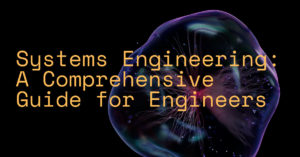
Systems engineering is a multidisciplinary field that focuses on how to design and manage complex systems over their life cycles. It is a process that helps us develop complex projects that meet program objectives in an efficient way. Efficiency in this context refers to reducing needless work, spotting flaws early in the design, and successfully coordinating among all significant program participants. This blog post seeks to give readers a thorough grasp of systems engineering, its significance, and the systems engineering methodology, in this case the V model.
What is Systems Engineering?
Systems engineering is a process used to develop something that is too complex to design and build as a single monolithic entity. It begins with a frequently ill-defined and hazy idea before giving it shape. It includes considering the system as a whole, comprehending its interactions with the outside world as well as those of its internal parts. It directs the engineering process to verify that the system is specified in a way that can be built and that it is meeting the project’s requirements.
Systems engineering attempts to describe a system that is compatible with all of these groups’ needs while also assisting in understanding each of their individual needs. The process of ensuring that each component performs as intended, followed by the integration of those components, until you have a top-level system that is operational and meets the initial goals, is also included.
How come systems engineering?
If the system that you’re constructing is sufficiently complicated, systems engineering is required. When compared to the time and effort needed to redo and fix a system that was improperly designed and documented at the outset, systems engineering will take less time and effort.
Systems engineering assists us in breaking down a system into manageable parts and designing how those parts should interact with one another, what they should be able to perform, and how we will test them. With model-based methods, we can quickly assess the system and allow us to hone in on a working design quickly, hopefully without lengthy failure and rework cycles.
Example of Systems Engineering
Take into account a project where a stakeholder requests a private air taxi service. The systems engineering method would begin by analyzing the needs of the stakeholders to determine what the customer ultimately wants to accomplish. From there, we may begin the process of concept research to identify every possible direction the project could go in. The viability of each of these notions is then examined using models and simulations.
Once a rough concept has been decided upon, we may begin to define it with respect to system requirements. Then we can look at how the functions interface with each other and how they are physically configured. We continue to validate that the concept will meet the needs of the stakeholder through analysis and simulations.
Then, we define the subsystems and determine the lower-level needs before beginning the initial configuration. Up to the point where we feel confident enough to start thorough design and manufacturing, we iteratively improve the architecture descriptions and carry on with these tasks, delivering ever-finer information.
The V model, or the systems engineering approach
The V model is a diagram that shows the lifecycle of a system. The reason it is known as the V model is because it follows a route that takes the form of a V: specification of the requirements, high-level design, detailed design, system implementation, system verification, and system maintenance.
The decomposition phase, where the system is disassembled from high-level concepts into specific designs, is represented by the left side of the V model. The integration phase, located on the right side of the V model, is where the system is rebuilt from its most basic parts back into a complete system.
The bottom of the V represents the point of peak decomposition and the beginning of integration. The V model highlights the necessity of upholding solid and distinct connections between the system’s requirements, design, and testing at all stages of decomposition and integration.
In the case of our hypothetical air taxi service, defining the high-level requirements (such as passenger capacity, range, and speed) and then breaking those down into subsystem requirements (such as propulsion, avionics, and airframe) and component requirements (such as motor specifications, software functions, and material properties) would be done on the left side of the V model.
The right side of the V model would then involve building and testing the individual components, integrating those into subsystems and testing them, and finally integrating the subsystems into the final air taxi system and verifying that it meets the original high-level requirements.
For managing and creating complicated projects, systems engineering is an essential procedure. It makes sure that every element of a system is taken into account and integrated into a whole that not only works properly but also satisfies the requirements of diverse stakeholders. The V model offers a methodical way to go from broad concepts to specific designs and back again, making sure the finished output achieves the initial goals. Engineers can design more effective, successful, and efficient systems by comprehending and putting to use the principles of systems engineering.
